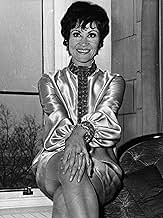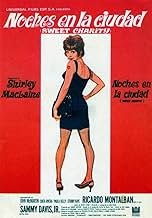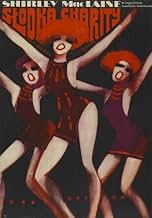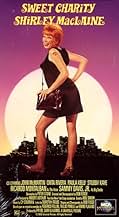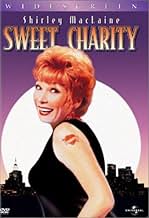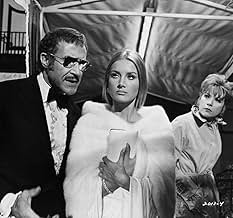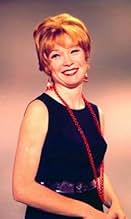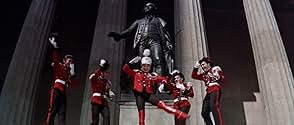Sweet Charity
- 1969
- Tous publics
- 2h 29min
NOTE IMDb
6,9/10
7,3 k
MA NOTE
Ajouter une intrigue dans votre langueA luckless taxi dancer in New York City seeks a better life and finds love along the way.A luckless taxi dancer in New York City seeks a better life and finds love along the way.A luckless taxi dancer in New York City seeks a better life and finds love along the way.
- Réalisation
- Scénario
- Casting principal
- Nommé pour 3 Oscars
- 6 nominations au total
Dante DiPaolo
- Charlie
- (as Dante D'Paulo)
Leon Alton
- Dancer
- (non crédité)
Avis à la une
10zetes
There's just something about this movie that I love. I had seen bits and pieces of it some half a dozen times in the past couple of years. Tonight I finally sat and watched all of it. In theory it sounds like blasphemy: a musical remake of Fellini's Nights of Cabiria. But somehow first time director Bob Fosse pulls it off, and enormously well. Fosse is daring and innovative in his direction. Not just in the musical numbers, where you would expect it, but in every scene. He plays, and he's obviously having a ball. After the direction, a high percentage of the film's success is due to Shirley MacLaine, who was never better as Charity Hope Valentine. As much as I love and care for Giullieta Masina's Cabiria, I love and care for MacLaine's Charity. She's such an enormously lovable character, and MacLaine is simply brilliant. Her comic timing is impeccable. Sweet Charity also proves an interesting time capsule of late 60s New York City. In the scene cognate to the Picadilly Club in Nights of Cabiria, we visit a trendy night club where the girls where blue feathers as hats. Clips of Cleopatra (the one with Claudette Colbert) and an unidentifiable W.C. Fields movie play on a big screen in the background. We visit a religious ceremony for hippies who sing The Rhythm of Life. Sammy Davis Jr. is the priest! In Cabiria, a parade of young people cheer her at the end of the film. In Sweet Charity, a group of hippies, amongst them a young Bud Cort, hand out flowers in the morning, just saying good morning to everyone they meet. This movie was a huge bomb when first released. Fosse is actually really lucky they gave him another chance at direction, and then he made a film instantly recognizable as a masterpiece, Cabaret. Sweet Charity did not deserve to fail so miserably. Just the fickle fingers of fate, I guess.
In Sweet Charity, Shirley MacLaine plays Charity, the original hooker with a heart of gold. Well, that's not entirely true; Sweet Charity is a remake of the Italian film The Nights of Cabiria, which won the Oscar for Best Foreign Film of 1957. In any case, the hooker with a heart of gold archetype is embodied by the protagonist in this story.
While the Italian film is depressing beyond belief—Don't get me wrong, I absolutely love the movie and have seen it many times—the musical is slightly different. There are many dramatic, depressing musicals, and this isn't one of them. It's fun and colorful with uplifting songs, a lighter title, and a generally sunny disposition. I won't spoil anything, but if you're looking for a downer, try Oliver instead.
Shirley MacLaine is darling! I know, it seems like I'm always talking about how cute she is, but she is particularly adorable and charming as Charity. Shirley got her start as a dancer, and in this movie, she's able to really show off her skills (and her legs). It's a Bob Fosse musical, so if you've never seen his choreography before, prepare yourself for a very different type of dancing. Dancers will stand perfectly still for several beats, breaking the stillness by a single shoulder shrug or finger flick. It's a very controlled, intense, stylized kind of dancing, one that uses a Hollywood camera to its advantage. The dance numbers are beautifully directed and framed in each shot. Usually, you'll either love Bob Fosse or hate him, so it might be a determining factor in your enjoyment of the film.
It's difficult to pull off the heart of gold hooker role convincingly. In my opinion, Giulietta Masina conveys the "seedy hooker" aspect of the character a little better in the original version, but it's also a darker, sadder film, so that makes sense. In Sweet Charity, Shirley MacLaine chews gum and sports a heart tattoo on her shoulder, but that's about it. Still, she nails the hopeful, utter faith in human nature aspect, which delights audiences and draws them into her story.
When I first watched the movie, I wasn't really too impressed with the songs. Now that I'm older and have written three musicals myself, I actually like Cy Coleman's and Dorothy Fields' creations better. For me, part of what makes an effective musical song is if the melody conveys the words of the song, even if the words are hidden. In "Big Spender", the famous song all the streetwalkers sing to a potential customer, the melody captures the boredom they feel, as well as the frustration simmering underneath. You can really feel it's a song that's been sung a hundred times a night. In "If They Could See Me Now", another famous song that Shirley MacLaine sings with a top hat and cane, it actually sounds like it's being sung on her tiptoes, while she's excited and afraid if she shouts it'll echo off the walls. And finally, one of my favorites, "There's Gotta be Something Better Than This": you can truly feel the frustration boiling over as the girls finally declare they've had enough of their terrible lives. To see what I mean, watch the YouTube clip of the song, and if you like it, rent the movie!
While the Italian film is depressing beyond belief—Don't get me wrong, I absolutely love the movie and have seen it many times—the musical is slightly different. There are many dramatic, depressing musicals, and this isn't one of them. It's fun and colorful with uplifting songs, a lighter title, and a generally sunny disposition. I won't spoil anything, but if you're looking for a downer, try Oliver instead.
Shirley MacLaine is darling! I know, it seems like I'm always talking about how cute she is, but she is particularly adorable and charming as Charity. Shirley got her start as a dancer, and in this movie, she's able to really show off her skills (and her legs). It's a Bob Fosse musical, so if you've never seen his choreography before, prepare yourself for a very different type of dancing. Dancers will stand perfectly still for several beats, breaking the stillness by a single shoulder shrug or finger flick. It's a very controlled, intense, stylized kind of dancing, one that uses a Hollywood camera to its advantage. The dance numbers are beautifully directed and framed in each shot. Usually, you'll either love Bob Fosse or hate him, so it might be a determining factor in your enjoyment of the film.
It's difficult to pull off the heart of gold hooker role convincingly. In my opinion, Giulietta Masina conveys the "seedy hooker" aspect of the character a little better in the original version, but it's also a darker, sadder film, so that makes sense. In Sweet Charity, Shirley MacLaine chews gum and sports a heart tattoo on her shoulder, but that's about it. Still, she nails the hopeful, utter faith in human nature aspect, which delights audiences and draws them into her story.
When I first watched the movie, I wasn't really too impressed with the songs. Now that I'm older and have written three musicals myself, I actually like Cy Coleman's and Dorothy Fields' creations better. For me, part of what makes an effective musical song is if the melody conveys the words of the song, even if the words are hidden. In "Big Spender", the famous song all the streetwalkers sing to a potential customer, the melody captures the boredom they feel, as well as the frustration simmering underneath. You can really feel it's a song that's been sung a hundred times a night. In "If They Could See Me Now", another famous song that Shirley MacLaine sings with a top hat and cane, it actually sounds like it's being sung on her tiptoes, while she's excited and afraid if she shouts it'll echo off the walls. And finally, one of my favorites, "There's Gotta be Something Better Than This": you can truly feel the frustration boiling over as the girls finally declare they've had enough of their terrible lives. To see what I mean, watch the YouTube clip of the song, and if you like it, rent the movie!
Bob Fosse's first opportunity to direct a movie was the 1969 film version of his own Broadway musical SWEET CHARITY, a musical based on the film NIGHTS OF CABERIA, with a book by Neil Simon and music by Cy Coleman and Doothy Fields. The story is best described by the film's subtitle: "The Adventures of a Girl Who Wants to be Loved". Shirley MacLaine, taking over the title role from Fosse's wife and muse, Gwen Verdon, plays Charity Hope Valentine, a pathetic thing who has worked as a taxi dancer in the Fandango Ballroom for eight years and has basically been a doormat to men all her life. As her friend Nickie (Chita Rivera) explains, "You run you heart like a hotel...you got men checking in and checking out all the time." The story is told in a series of amusing and touching vignettes which lead to Charity meeting the possible man of her dreams, a milquetoast named Oscar Lindquist (John McMartin, reprising his Broadway role). This film died at the box office in 1969 and I'm not sure why except for the fact that this was a period when musicals just weren't being made anymore and that's a shame because the movie is extremely entertaining, thanks to the bravura performance by MacLaine as Charity and the extraordinary choreography by Bob Fosse. I can watch this movie over and over again just to watch the dance numbers. The raw sensuality of "Hey Big Spender"...the angular, disjointed and pointed moves of "Rich Man's Frug"...the Broadway exuberance of "There's Gotte be Something Better Than This", exuberantly danced by MacLaine, Rivera, and Paula Kelly...the brilliant jazzy classic Fosse moves of "Rhythm of Life"..and the pure joy of "I'm a Brass Band." All of Fosse's choreographic signatures are present here...the hats, the gloves, the turned in feet, the disjointed body parts, the expressionless dancer faces, it's all here to be watched and studied and marveled over. For dance purists and Fosse devotees, SWEET CHARITY is a must.
Sure, Bob Fosse sometimes indulges in trendy late-60's stylistic touches like freeze-frames and crash-zooms. Some of the jokes by Neil Simon are corny, and Shirley MacLaine can be a little hard to take sometimes. The film also suffers from the bloated, over-produced quality that infected most 60's major studio musicals.
The dull non-musical scenes are a chore to sit through, but when one of Fosse's amazing production numbers begins, Sweet Charity soars into the sublime. Fosse was quite simply a genius, and the great showcase numbers such as "Hey Big Spender" and "Rich Man's Frug" are as brilliant as any dance numbers ever put on film.
Shifting configurations of dancers, contorted body poses, dance steps that are by turns awkward and graceful, a studied contrast between clustering dancers and separating dancers -- it is hard to describe the magic of the Pompeii Club sequence. I've always felt that Fosse's choreography has the same sense of space and volume as Cubist painting.
Fosse's camera placement and camera movement capture an ideal "in-the-round" feeling of choreographed numbers that one cannot experience in the theater. For a first-time film director, Fosse revealed an amazing facility for the form. Usually theater directors don't take to the medium of film as quickly as Fosse did. Usually, theater directors make visually unexciting films that feel stage-bound. Not Fosse -- Sweet Charity, despite some flaws, doesn't play like a filmed stage play, it has the visual panache of Fellini and Godard.
Sweet Charity was just a warm-up, Fosse's personal film school at Universal's expense, before he truly mastered the form of film-making with the classic Cabaret.
The dull non-musical scenes are a chore to sit through, but when one of Fosse's amazing production numbers begins, Sweet Charity soars into the sublime. Fosse was quite simply a genius, and the great showcase numbers such as "Hey Big Spender" and "Rich Man's Frug" are as brilliant as any dance numbers ever put on film.
Shifting configurations of dancers, contorted body poses, dance steps that are by turns awkward and graceful, a studied contrast between clustering dancers and separating dancers -- it is hard to describe the magic of the Pompeii Club sequence. I've always felt that Fosse's choreography has the same sense of space and volume as Cubist painting.
Fosse's camera placement and camera movement capture an ideal "in-the-round" feeling of choreographed numbers that one cannot experience in the theater. For a first-time film director, Fosse revealed an amazing facility for the form. Usually theater directors don't take to the medium of film as quickly as Fosse did. Usually, theater directors make visually unexciting films that feel stage-bound. Not Fosse -- Sweet Charity, despite some flaws, doesn't play like a filmed stage play, it has the visual panache of Fellini and Godard.
Sweet Charity was just a warm-up, Fosse's personal film school at Universal's expense, before he truly mastered the form of film-making with the classic Cabaret.
This is loaded to the brim with that dancing and just general idiosyncratic "cool" feeling that made Fosse who he was as a creator. "Big Spender" and "If My Friends Could See Me Now" are all-timer Musical numbers in film history. And yeah, a couple of the numbers have certainly dated (hearing Sammy Davis tell a bunch of Broadway Hippies to "Sock it to me" in the "Rhythm of Life" number is worth a major eye-roll), plus Fosse's attempts to do uh La Jetee type still image montages at a couple of points. However, Shirley MacLaine is often so moving in a role that others might have played a little less intensely felt (what sold me was the job interview scene, which is just about perfect, but her comic timing is impecable). She's adorable but also very serious as a person, which is hard to pull off.
It's big and flashy and a little bit silly (I like to call Ricardo Montalban Casanova Khan in this), and the director jumps off from Fellini and Neil Simon (in a Peter Stone script) for as much audacious advantage as he can. Not all of it works, but it's far from a "disaster" like Pauline Kael called it. 7.5/10
Le saviez-vous
- AnecdotesAlthough uncredited, Gwen Verdon was assistant choreographer in the film version of Sweet Charity (1969).
- GaffesIn the "Aloof" movement of "The Rich Man's Frug," two of the male principal dancers walk down the stairs to light a woman's cigarette, while the others dance behind them. The background choreography in this shot leads directly to the triangle formation of the next shot, and the two men are now in the middle of the group, although there was no time for them to reach that position.
- Citations
Charity Hope Valentine: Wow! This place sure is crawlin' with celebrities. I'm the only person here I never heard of.
- Versions alternativesLaserdisc version contains an alternative ending. After Oscar leaves Charity, he starts to go crazy in his apartment. He then realizes that despite Charity's faults, he really can't live without her. He finds Charity on the bridge in Central Park and, thinking she's going to jump, falls into the river. Charity jumps in after Oscar and forgives him. The two then walk off together, soaking wet, through the park. Bob Fosse thought this ending was too corny, and decided to use the depressing, yet more inspirational, ending for the film's major release.
- ConnexionsFeatured in Sweet Charity: From the Stage to the Screen (1969)
- Bandes originalesMy Personal Property
(uncredited)
Music by Cy Coleman
Lyrics by Dorothy Fields
Performed by Shirley MacLaine
Meilleurs choix
Connectez-vous pour évaluer et suivre la liste de favoris afin de recevoir des recommandations personnalisées
- How long is Sweet Charity?Alimenté par Alexa
Détails
- Date de sortie
- Pays d’origine
- Langue
- Aussi connu sous le nom de
- Sweet Charity: The Adventures of a Girl Who Wanted to Be Loved
- Lieux de tournage
- Société de production
- Voir plus de crédits d'entreprise sur IMDbPro
Box-office
- Budget
- 20 000 000 $US (estimé)
- Durée2 heures 29 minutes
- Rapport de forme
- 2.35 : 1
Contribuer à cette page
Suggérer une modification ou ajouter du contenu manquant


